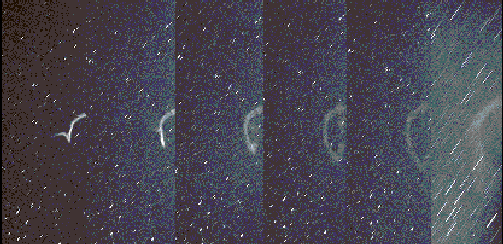The Leonid Meteor Shower

Credit & Copyright: P. Jenniskens
(NASA
/Ames)
Explanation:
The Leonid Meteor Shower will likely reach its peak in the
early hours this Monday morning.
Though the Moon will be bright,
Leo,
the shower's
radiant point,
will be well above the eastern horizon from Western North America and the
Pacific region during this period.
This year's Leonids may prove particularly
exciting as observers
anticipate
the legendary Leonid storm of activity will occur sometime
during the next few apparitions of this annual meteor shower - although
most expect the meteor storm to occur in 1998 or 1999.
Meteor showers result from
debris left by passing comets.
The Leonids specifically are small pieces of
Comet Tempel-Tuttle.
In the
above series of time-lapse, 1-minute exposures,
a 1995 Leonid is seen to leave a train of hot air that glowed
persistently for several minutes.
Authors & editors:
Robert Nemiroff
(MTU) &
Jerry Bonnell
(USRA)
NASA Web Site Statements, Warnings,
and Disclaimers
NASA Official: Jay Norris.
Specific
rights apply.
A service of:
LHEA at
NASA /
GSFC
& Michigan Tech. U.

